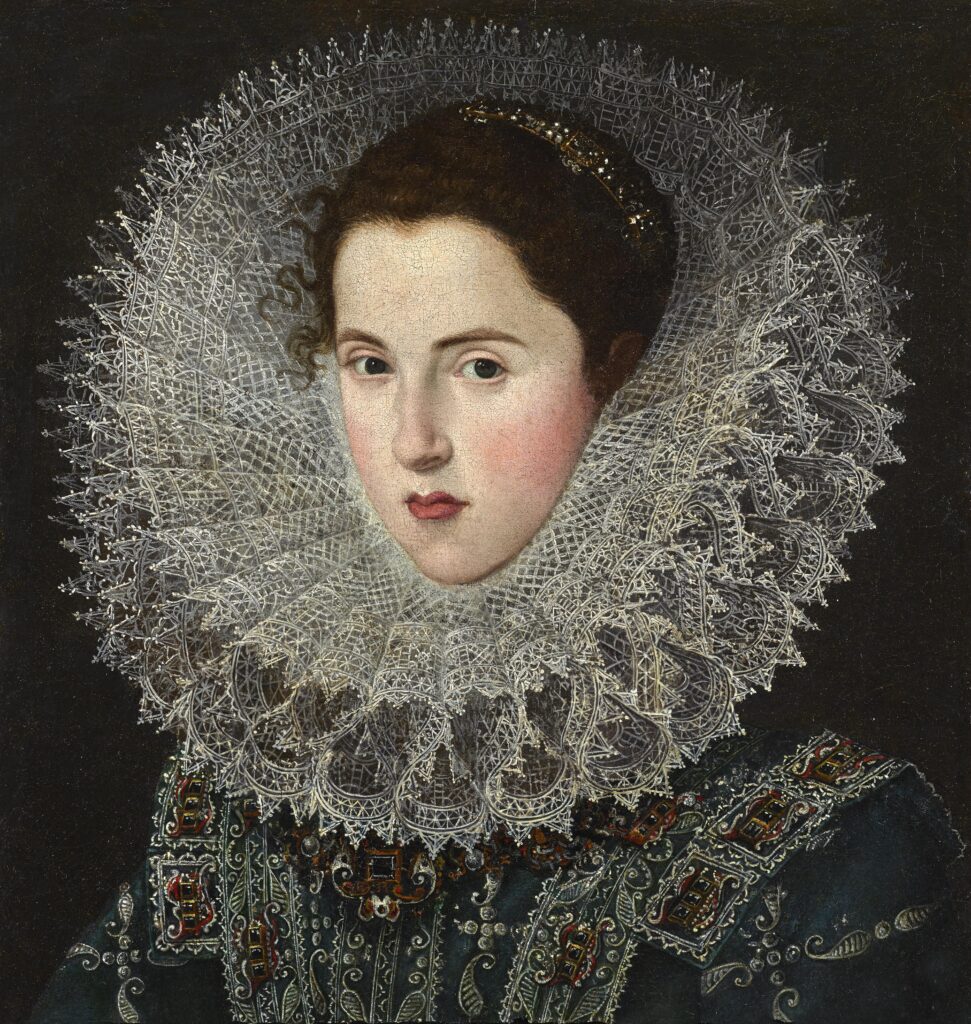Juan Pantoja de la Cruz
1553 - 1608
A Portrait of Ana de Velasco y Giron, later Duchess Consort of Braganza (1585 – 1607)

Essay:
Juan Pantoja de la Cruz began his career in Madrid as a pupil of Alonso Sanchez Coello. After Coello's death in 1585 de la Cruz followed his Master as official court painter to the Spanish King, Philip II. There is a possibility he also collaborated a great deal with Coello on some of the artist's mature works. Primarily a painter of the Spanish royal family and nobility, during his highly successful career de la Cruz completed religious works, frescos, and still lifes, and was highly popular at court.
Like his master he began by copying works by Titian (for example the copy of Charles V now in the Prado) and Antonis Mor with great ability; two artists who were highly prized by the King. The skills and manner he learnt from these copies are reflected in his portraiture and especially the faces of his sitters. He was also particularly well respected for his skill in depicting jewellery and clothing. Indeed, many of his sitters are dressed in the most elaborate of courtly costumes and are heavily laden with jewels. He was later to be employed by Philip III, who ordered numerous commissions from him.
De la Cruz's most important religious commission was a joint work executed with Bartolome Carducho for the Monastery of San Augstin in Valladolid. He painted some animal compositions, but these are rare. They must have been of exceptional quality as there is a story (perhaps legend) that told of an eagle bring brought in front of a painting of an eagle and promptly attacking the canvas.
-
Juan Pantoja de la Cruz has executed a very striking likeness of a young court lady, perhaps in her mid to late teens, dressed in the rigid splendour of the Spanish court. The ruff in particular has been painted with splendid detail and confidence. The swirling pleats with tapered ends help to date the portrait to around the turn of the 17th century.
The identity of the sitter can with some certainty be judged to be Ana de Velasco y Giron (1585 - 1607), a Spanish noblewoman and mother of John IV of Portugal. This identification comes from an almost identical portrait in the Alicia Koplowitz Collection by de la Cruz, signed and dated 1603, which names the sitter in the inscription.
The Koplowitz version is three-quarter length with the sitter, aged 18, wearing the same clothing as in the present picture save for the absence of the pearl jewellery seen in the Koplowitz version: a pearl-encrusted tiara, a pearl earring, and a pearl necklace. The Koplowitz version is a wedding portrait painted when Ana married Teodosio II of Braganza (1568 - 1630) in 1603 (Ana is identified as 'de Braganza' in the inscription). The pearls were likely a gift from Teodosio; the tiara in particular symbolic of her elevation in status, wealth, and maturity. The reason for absence of the pearls and inscription in the present picture could be that our portrait may in fact be an earlier version painted by de la Cruz before Ana's wedding.
Born in Naples to noble Spanish parents Juan Fernández de Velasco y Tovar and his first wife Duchess María Tellez-Girón. Ana's maternal grandfather was Pedro Téllez-Girón y de la Cueva, 1st Duke of Osuna and viceroy of Naples. The family moved back to Spain the year after Ana was born and she was raised in the Enlightenment milieu of the Spanish court.
After the wedding the couple lived at the Ducal Palace of Vila Viçosa around 150 kilometers east of Lisbon where Teodosio commissioned a grand scheme of redecorations to suit the taste of his young cosmopolitan wife. Sadly, Ana died at the palace at the age of just 22 after never recovering from the birth to their fourth child. Her first son John would become John IV of Portugal (1605 - 1656) once Portugal gained independence from Spain in 1640.
Provenance:
Private Collection, Italy